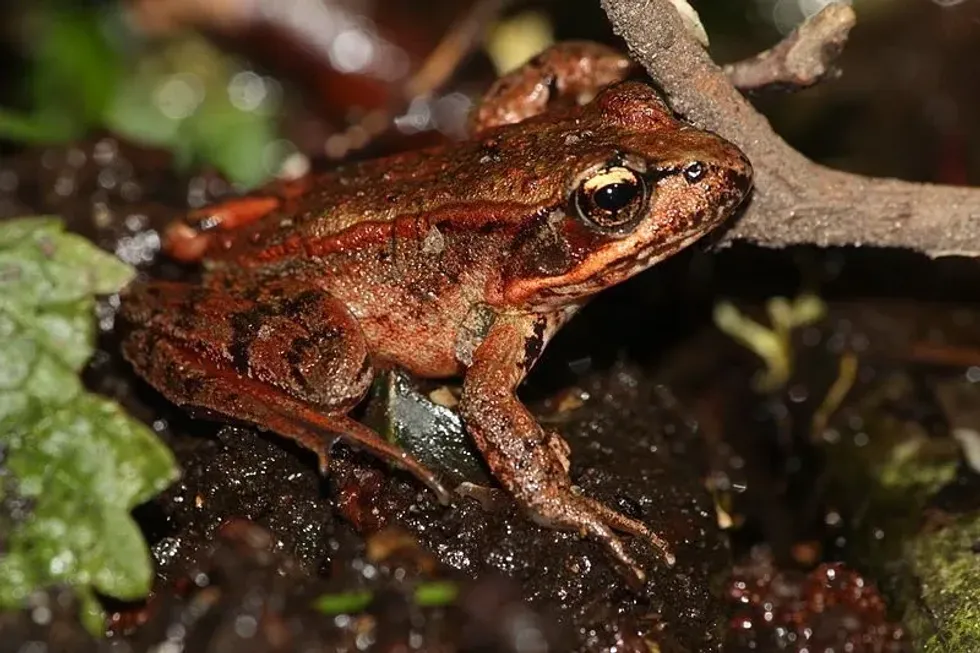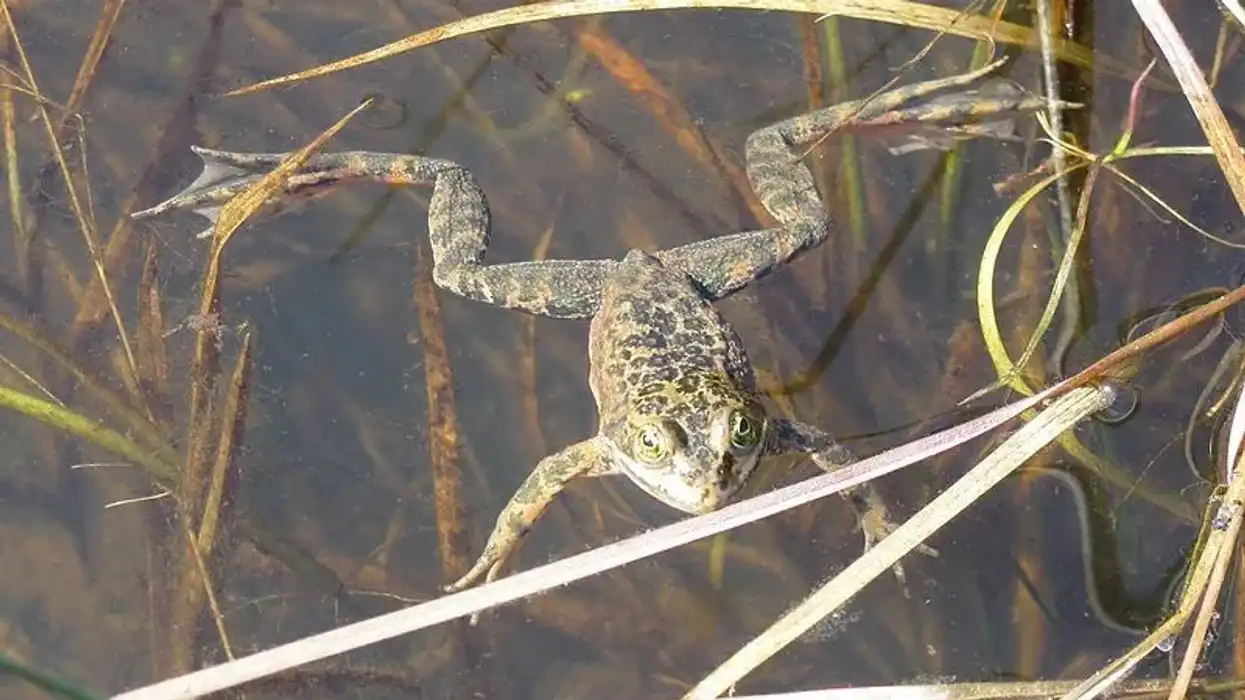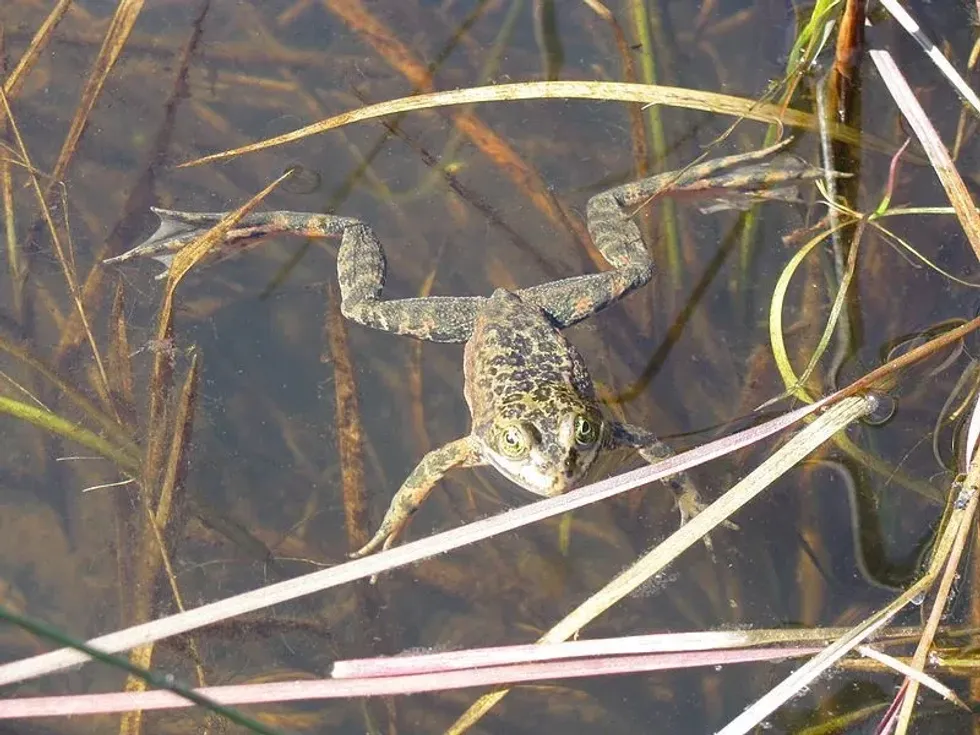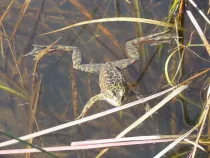Fun Oregon Spotted Frog Facts For Kids

If you like reading about frogs, then you should give this article on Oregon spotted frog a read. Oregon spotted frogs (Rana pretiosa) are medium-sized frogs of aquatic habitats that are endemic to the Northwest Pacific.
They are named so because of the dark spots present on the entire body of the frog. It usually inhabits the shallow water habitats containing plenty of vegetation that are used as cover and for basking as well. They are relatively more aquatic than their other anuric counterparts.
Oregon spotted frogs were once found in abundance throughout their range; however, at present, they have disappeared from 78-90% of their former range. They are the first species that were enlisted on an emergency basis in the list of endangered species of Canada because of the steep fall in their populations.
Their population is extremely threatened primarily because they are losing their habitats at an accelerated pace. Apart from that, they are also threatened by some predators that are depleting their required natural resources.
In 2004, the U.S. Fish and wildlife service listed these frogs in the conservation list of the Endangered Species Act.
To know more about the life history of the frog, keep on reading these facts. For similar content, check out natterjack toad facts and common toad facts too.
Oregon Spotted Frog Interesting Facts
What type of animal is an Oregon spotted frog?
Oregon spotted frog (Rana pretiosa) is a type of aquatic frog.
What class of animal does an Oregon spotted frog belong to?
The Oregon spotted frog (Rana pretiosa) of the Anura order, and Ranidae family belongs to the class Amphibia, the common class for all amphibians.
How many Oregon spotted frogs are there in the world?
Oregon spotted frogs occur in small populations throughout their range. In a population survey of the late 90s, it was observed that around 8,300 eggs were laid by the frog species in a certain area.
That number decreased to 1500 eggs in a span of 10-15 years. This decrease in the number of eggs indicated a steep fall in their populations and fueled the need for immediate conservation actions.
They have totally disappeared from most parts of their range. The present population has not been estimated, but the trend of declining adult populations is clear by the lowered number of eggs laid. Current surveys showed that these spotted frogs occur mostly in Oregon along with some fragmented populations in Washington.
The U.S. Fish and Wildlife Service are working towards improving their populations by introducing effective conservation measure.
Where does an Oregon spotted frog live?
Oregon spotted frogs are native to the Northwestern Pacific. Based on the data about the frog's life history, they were believed to live in Oregon, Washington, British Columbia, and California.
The current range of the species extends from southwest British Columbia up to south-central Washington, running southwards through the east of Puget Trough and the Cascades range. In Oregon, the species occur until the Klamath Basin in the south.
The Californian population was extremely threatened, and the species is believed to be extirpated or locally extinct from there.
The species have also become locally extinct throughout much of Washington and western Oregon. In Oregon, they are found in few counties like Deschutes, Wasco, and Lane, while in Washington, they populate Thurston, Whatcom, and Skamania counties.
What is an Oregon spotted frog's habitat?
This frog is a typically aquatic species that spend most of its life inside or near water bodies. Common Oregon spotted frog habitat includes ponds, lakes, springs, irrigation canals, and sluggish streams.
Floating plants or aquatic vegetation are their basic requirements for habitats that provide warmth as well as help them to hide from predators. They prefer quiet and fairly large water bodies with warm water.
In the rainy season, the species climb on land and disperse into forests and grassland along the water. At present, alterations and disturbances along the species range have made the population of Oregon spotted frog critical. Habitat loss has left the species highly endangered.
The U.S. Fish and Wildlife Service is trying to help in the conservation of their habitats and natural resources to restore their population.
Who does Oregon spotted frog live with?
Oregon spotted frogs live together in large concentrations inhabiting a lake, pond, stream, or spring. For this reason, they prefer large water bodies that can accommodate larger populations. The female lays eggs in a pile.
How long does an Oregon spotted frog live?
There is no credible information regarding the lifespan of this species of frogs. They are believed to have a short lifespan of two to five years.
How do they reproduce?
Oregon spotted frog's breeding season starts in late winter and lasts for a very short while, less than four weeks. They breed strictly in quiet water like in shallow lakes or ponds containing lots of tall and dense vegetation.
The males call quietly from the sites where the females lay eggs throughout the day or night to attract females. After breeding, the females lay eggs in communal piles at the traditionally selected oviposition.
The laying season varies according to different places depending on the climate conditions. In some places, the frog lays eggs from late February to march, while in some places it occurs from May to June.
The adult female spotted frog reproduces every year and lays a single egg mass. The egg masses are usually laid in communal oviposition sites used by around 10-75 individuals.
A single egg mass is believed to consist of 643 eggs on average. The eggs are laid in shallow water so that they get an adequate amount of warmth required for them to hatch.
Once the eggs hatch, the larvae transform into tadpoles within 18-30 days. The transition from a tadpole to a frog takes about four months.
The tadpoles grow on their own; their parents neither takes care of them nor do they feed them. Male Oregon spotted frogs sexually mature between one and two years old while the females mature between two and three years old.
What is their conservation status?
Oregon spotted frogs are listed as Vulnerable in the IUCN Red List. They were also classified as a Threatened species under the Endangered Species Act.
Their population has decreased more than 30% in the last three generations. The main reasons for their decline are linked to the decrease of their habitable lands, degradation of habitat, and threats from known Oregon spotted frog predators and invasive species.
Animals like bullfrogs and some predatory fishes are either taking possession of their habitat or feeding on them, reducing their numbers largely.
They have been protected and conserved in national parks by various federal management services like the U.S. Fish and Wildlife Service, but desired success has not been achieved as of yet.
Oregon Spotted Frog Fun Facts
What does Oregon spotted frog look like?

*This is an image of a northern red-legged frog from the same genus as Oregon spotted frog. If you have an image of an Oregon spotted frog, please let us know at hello@kidadl.com.
An Oregon spotted frog's appearance varies with age. As tadpoles, they have a completely brown body with whitish underparts, and their body does not contain any dark spots.
The frog at their young ages tend to be brown, but with age, this brown color slowly transforms into the olive green color. The adults have a shade of reddish-brown, and their color changes to a more reddish shade with increasing age.
The dorsal part of the old frogs, stretching from chest to abdomen, becomes brick red.
Both the adults and the juveniles have black spots that cover the head, legs, back, and sides. The edges of the spots are ragged edges that intensify as the frogs get older.
The hind legs of the frog are comparatively shorter than the front legs, and the feet are completely webbed. The beady eyes on top of the head are upturned and remain uncovered by the eyelids.
How cute are they?
They have a very unique red color which might attract people towards it. However, their cuteness is subjective according to the perception of an individual.
How do they communicate?
Frogs communicate by making a 'kreck-eck' type of sound. They call by breathing air and closing their nostrils. The males also have distinctive mating calls that help in attracting the females.
How big is an Oregon spotted frog?
The length of an Oregon spotted frog (Rana pretiosa) from the snout till the vent ranges between 1.8-4 in (4.4-10.2 cm). They are bigger than a blue poison dart frog.
How fast can an Oregon spotted frog move?
Oregon spotted frogs are calm by nature and do not show many movements, but when necessary, they can jump long distances. However, their speed has not been determined yet.
How much does an Oregon spotted frog weigh?
The weight of Oregon spotted frogs is unknown.
What are the male and female names of the species?
The male and the female frogs do not have any specific names. Both of them are called Oregon spotted frogs.
What would you call a baby Oregon spotted frog?
Baby frogs are referred to as larvae and tadpoles respectively, according to their life stage.
What do they eat?
Oregon spotted frogs are opportunistic predators. The frogs can feed on almost anything that they catch while swimming on the water surface. Some common foods of the frog include freshwater shrimp, a wide variety of insects, spiders, and snails. As tadpoles, they thrive by grazing on algae, plant tissue, and debris.
Are they poisonous?
There are no records regarding the poison content of the frog.
Would they make a good pet?
Petting them is illegal throughout the United States because of the reducing numbers of their population.
Did you know...
In the winter, the frogs hibernate in the mud below the water. They can go up to 1 ft (30.4 cm) inside the mud.
Why are Oregon spotted frogs endangered?
There are many factors that can be considered as potential reasons for the species to be endangered. The first factor that needs to be addressed is the disturbances or loss of Oregon spotted frog's habitat.
These stable species of frog are not well accustomed to changing habitat conditions and are continuously facing the harassment of habitat alterations. The actions of humans and methods of modern development affect their habitat negatively and have even cost them their lives.
Urbanization, construction of dams, altering drainage patterns, infilling lands or dewatering for agricultural uses, and excess grazing are the main causes behind their changing habitat.
The remaining population is unable to move to other places due to changes in hydrology. As a result, disparity of concentration is noticed in different places.
Apart from that, Oregon spotted frogs are also affected by the introduction of non-native predatory fishes and bullfrogs in their habitat. These species are replacing them in their own habitat by either feeding on them or displacing them from the connected groups.
How far can they jump?
These frogs are middle-sized frogs that jump great distances to escape from their predators. They have shorter legs than other frogs of similar size, but they can jump longer distances from the others. However, there is no information about the exact distance they cover in a jump.
Here at Kidadl, we have carefully created lots of interesting family-friendly animal facts for everyone to discover! Learn more about some other amphibians from our spadefoot toad facts and spring peeper facts pages.
You can even occupy yourself at home by coloring in one of our free printable oregon spotted frog coloring pages.
We Want Your Photos!
More for You
Bachelor of Arts specializing in Journalism and Mass Communication, Postgraduate Diploma in Sports Management

Moumita DuttaBachelor of Arts specializing in Journalism and Mass Communication, Postgraduate Diploma in Sports Management
A content writer and editor with a passion for sports, Moumita has honed her skills in producing compelling match reports and stories about sporting heroes. She holds a degree in Journalism and Mass Communication from the Indian Institute of Social Welfare and Business Management, Calcutta University, alongside a postgraduate diploma in Sports Management.
Bachelor of Arts specializing in English Literature, Masters of Art specializing in English and Communication Skills

Sonali RawatBachelor of Arts specializing in English Literature, Masters of Art specializing in English and Communication Skills
Sonali has a Bachelor's degree in English literature from Guru Gobind Singh Indraprastha University and is currently pursuing a Master's in English and Communication from Christ University. With considerable experience in writing about lifestyle topics, including travel and health, she has a passion for Japanese culture, especially fashion, and anime, and has written on the subject before. Sonali has event managed a creative-writing festival and coordinated a student magazine at her university. Her favorite authors are Toni Morrison and Anita Desai.
Disclaimer
1) Kidadl is independent and to make our service free to you the reader we are supported by advertising. We hope you love our recommendations for products and services! What we suggest is selected independently by the Kidadl team. If you purchase using the Buy Now button we may earn a small commission. This does not influence our choices. Prices are correct and items are available at the time the article was published but we cannot guarantee that on the time of reading. Please note that Kidadl is a participant in the Amazon Services LLC Associates Program, an affiliate advertising program designed to provide a means for sites to earn advertising fees by advertising and linking to Amazon. We also link to other websites, but are not responsible for their content.
2) At Kidadl, we strive to recommend the very best activities and events. We will always aim to give you accurate information at the date of publication - however, information does change, so it’s important you do your own research, double-check and make the decision that is right for your family. We recognise that not all activities and ideas are appropriate for all children and families or in all circumstances. Our recommended activities are based on age but these are a guide. We recommend that these ideas are used as inspiration, that ideas are undertaken with appropriate adult supervision, and that each adult uses their own discretion and knowledge of their children to consider the safety and suitability. Kidadl cannot accept liability for the execution of these ideas, and parental supervision is advised at all times, as safety is paramount. Anyone using the information provided by Kidadl does so at their own risk and we can not accept liability if things go wrong.
3) Because we are an educational resource, we have quotes and facts about a range of historical and modern figures. We do not endorse the actions of or rhetoric of all the people included in these collections, but we think they are important for growing minds to learn about under the guidance of parents or guardians.







